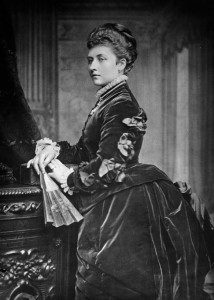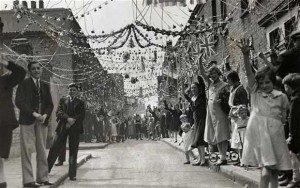by Lucinda Hawksley
The Locock Family Secret – Princess Louise
It was while looking into the rumors concerning Princess Louise’s illegitimate baby that I came into contact with the Locock family. I read newspaper accounts of two court cases, in which a man named Nicholas Locock had attempted to gain permission for a MDNA (Mitachondria DNA) test to prove he was descended from Princess Louise. After twice going through the high courts, the Locock family’s plea was refused.

“Reprinted with the permission of St. Martin’s Press from Queen Victoria’s Mysterious Daughter by Lucinda Hawksley.”
The story of the Locock family and Princess Louise begins at the end of 1867, when a baby boy was adopted by the son of Queen Victoria’s accoucher (in today’s language he would be called a gynecologist). The accoucher, Sir Charles Locock, had five sons; the one who adopte d the baby was Frederick Locock. In the spring of 1867 Frederick moved into an apartment near St James’s Palace. Nick Locock believes it may have been a ‘grace and favor’ apartment. Two months later, the family suffered a bereavement, when Sir Charles’s wife, Amelia, died, yet in August 1867, just six weeks after the death of his mother, Frederick married his fiance Mary Blackshaw. They married in a register office, not a church, in unseemly haste after such a bereavement (the mourning period for the death of a parent was expected to be one year). Four months later, the couple adopted their son; he would be their only child. The baby, who was named Henry Frederick Leicester Locock, appears to have had no birth certificate – none has ever been found. The names of his biological parents are not included on any document (or, at least no documents that are in the public domain). In late December, Charles Locock wrote a letter to a friend in which he remarked that, unusually, he would not be able to have any of his sons with him for the end of the year and that he planned on taking a long holiday overseas. The letter suggests that he was shielding a secret and that he was unhappy about it.
Royal sources have been quick to refute the suggestion that Princess Louise was Henry Locock’s mother, because she could not have given birth on the date written in the Locock family’s Birthday Book, 30 December 1867. It seems likely that this was the date of the adoption rather than the baby’s birth. At the end of December 1867, Queen Victoria’s legal advisers were summoned to visit her. The newspapers reported that at this time 150 Scots Fusiliers were guarding the royal family, allegedly against the threat of Fenian attack. The Locock family believe that baby Henry was born at the end of 1866, or perhaps very early in 1867. It is probable that he was looked after by servants, with ‘access to his mother’. Henry Locock would later tell his own children that he was Princess Louise’s son and that his biological mother had ‘access’ to him in his boyhood years. Despite a seemingly happy marriage, Mary and Frederick had no other children; Mary’s health was poor and perhaps she already knew she would have trouble conceiving. The couple made no secret of the fact that the baby was not their biological child and Frederick wrote in several legal documents about his ‘adopted son’.
Mary and Frederick adopted their son at the end of December 1867. On 20 1867 the Isle of Wight Observer noted that Lady Stirling (the mother of Walter Stirling) had arrived on the island. She had come to stay with Sir Charles Locock. July On 1 December 1867 Alix sent a sympathetic letter to Louise from Sandringham, in which she wrote: ‘My poor little pet I am afraid you have not been enjoying yourself so very well lately.’ If, as Henry would later attest, he remained with his mother Princess Louise at the start of his life, Alix’s letter would have been sent as Louise was preparing to give him up. A year later, Alix would write to her again, worrying that Louise had been looking ‘quite worn and sad’ when they had seen each other. At Christmas in 1869, approaching the second anniversary of Henry Locock’s adoption, Alix wrote another supportive and suggestive letter to her sister-in-law: ‘I hope my poor pet has not been worried and bothered lately about that tiresome old affair of yours! and that your sisters have given you a little rest now.’

Image is in the public domain via Check this for reference/
Henry Locock’s grandson, Nick Locock, was a six-year-old boy by the date of King George V’s jubilee celebrations. Princess Louise was regularly in the news at this time, partly because she was a loved relation of the new king, but also because she was still so newsworthy, thanks to her great age and the story of her life as an artist. Nick recalls his father telling him during the coronation that they were descended from Princess Louise. The family’s history, as it was told to Nick, was that his grandfather was the princess’s son and that, although the baby had then been adopted by the Locock family, he had been given ‘access’ to Princess Louise all through his childhood. Nick’s grandfather, Henry (who was always known in the Locock family by his middle name of Leicester), had died when his own children were still young, but Nick’s father recalled his stories of childhood parties with all the royal children. One story that always made his children laugh was Henry’s reminiscence of playing croquet on the lawn at Osborne House, when one of his royal cousins cheated. This infuriated the little boy so much that he hit his cousin with a croquet mallet: the cheater in question was the future Kaiser Wilhelm.
As he was growing up, Nick discovered that he was not the only Locock child to have been told what he describes as the ‘family legend’. ‘Subsequently,’ he told me when we met, ‘I realized that not only my brother and sister, but each of my eleven cousins had been told the same story by their parents. It was apparent that [Henry] had told each of his six children before his death in 1907, that his mother was Princess Louise.’
LUCINDA HAWKSLEY is the author of Queen Victoria’s Mysterious Daughter and is a writer and lecturer on art history and nineteenth-century history. She has written biographies of the pre-Raphaelite muse Lizzie Siddal, Charles Dickens, and Katey, one of Dickens’ children. She is the great, great, great granddaughter of Charles and Catherine Dickens and is a patron of the Charles Dickens Museum in London.
Visit her Web site at www.lucindahawksley.com.
